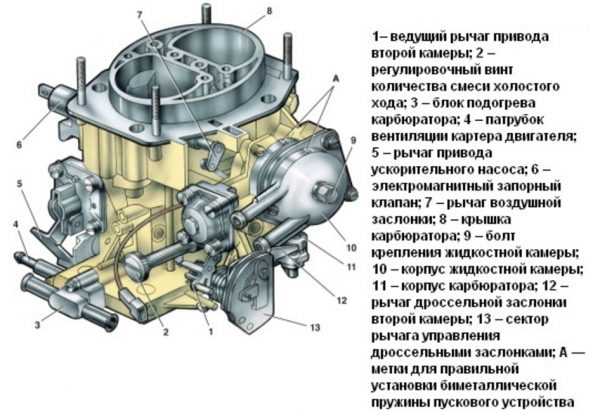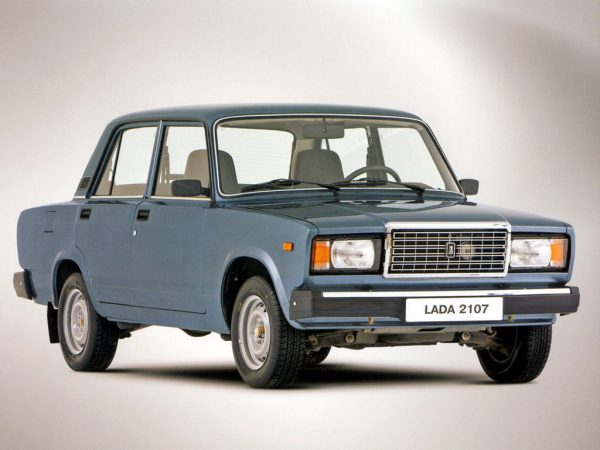
We independently control fuel consumption on the VAZ 2107
Content
Fuel consumption is the most important characteristic of a vehicle. The efficiency of the engine is largely determined by the amount of fuel that it consumes. This rule is true for all cars, and the VAZ 2107 is no exception. A responsible driver carefully monitors how much gasoline his "seven" consumes. In certain situations, the amount of gasoline consumed can increase dramatically. Let's figure out what these situations are and how to eliminate them.
Fuel consumption rates for VAZ 2107
As you know, the VAZ 2107 at different times was equipped with different engines.

Consequently, fuel consumption rates also changed. Here's what it looked like:
- Initially, the VAZ 2107 was produced only in the carburetor version and was equipped with a one and a half liter engine of the 2103 brand, whose power was 75 hp. With. When driving around the city, the first carburetor "sevens" consumed 11.2 liters of gasoline, and when driving on the highway, this figure dropped to 9 liters;
- in 2005, instead of a carburetor engine, a one and a half liter injection engine of the 2104 brand began to be installed on the "sevens". Its power was lower than that of its predecessor, and amounted to 72 hp. With. The fuel consumption was also lower. In the city, the first injector "sevens" consumed an average of 8.5 liters per 100 kilometers. When driving on the highway - 7.2 liters per 100 kilometers;
- finally, in 2008, the "seven" received another engine - the upgraded 21067, which is by far the most popular. The volume of this engine is 1.6 liters, power - 74 liters. With. As a result, the fuel consumption of the latest injector “sevens” increased again: 9.8 liters in the city, 7.4 liters per 100 kilometers on the highway.
Climate and consumption rates
The climate in which the machine is operated is the most important factor affecting fuel consumption. It is impossible not to mention this factor. In winter, in the southern regions of our country, the average fuel consumption can vary from 8.9 to 9.1 liters per 100 kilometers. In the central regions, this figure varies from 9.3 to 9.5 liters per 100 kilometers. Finally, in the northern regions, winter fuel consumption can reach 10 liters or more per 100 kilometers.
Machine age
The age of the car is another factor that many car enthusiasts often overlook. It's simple: the older your "seven", the greater its "appetite". For example, for cars older than five years with a mileage of more than 100 km, the average fuel consumption is 8.9 liters per 100 km. And if the car is more than eight years old and its mileage exceeds 150 thousand km, then such a car will consume an average of 9.3 liters per 100 km of track.
Other factors affecting fuel consumption
In addition to climatic conditions and the age of the car, many other factors affect fuel consumption. It is not possible to list them all within the framework of one small article, so we will focus only on the most basic ones, the impact of which the driver can reduce.
Low tire pressure
Like any other car, the VAZ 2107 has tire pressure standards depending on the load. For standard tires 175–70R13, these figures are as follows:
- if there are 3 people in the cabin, then the pressure in the front tire should be 1.7 bar, in the rear tire - 2.1 bar;
- if there are 4–5 people in the cabin, and there is cargo in the trunk, then the pressure in the front tire should be at least 1.9 bar, in the rear 2.3 bar.
Any downward deviation from the above values inevitably leads to an increase in fuel consumption. This is due to the fact that a flat tire has a significantly larger contact patch with the road. In this case, the rolling friction increases significantly and the engine is forced to burn more fuel in order to overcome this friction.

The relationship between pressure and consumption is inverse: the lower the tire pressure, the higher the fuel consumption. In practice, this means the following: if you reduce the pressure in the tires of the "seven" by a third, then fuel consumption can increase by 5-7%. It should also be noted here that driving on half-flat wheels is simply dangerous: on a sharp turn, the tire can fly off the rim. The wheel will disassemble, and the car will immediately lose control. This could cause a serious accident.
Driving style and its correction
Driving style is another important factor, the influence of which the driver can easily adjust on his own. If the driver wants to reduce fuel consumption, the car must move as evenly as possible. First of all, this rule applies to braking. You should slow down as little as possible (but of course, not at the expense of your own safety). To fulfill this condition, the driver must learn to clearly predict the situation on the road, and then accelerate the car to the speed that is appropriate at the moment, without exceeding. A novice driver should learn how to smoothly drive up to traffic lights, change lanes in advance, etc. All these skills come with time.

Of course, the driver still has to slow down. But at the same time, you need to know the following: on injection machines with manual gearboxes, braking with the gear engaged turns off the injection system. As a result, the car continues to move by inertia without consuming fuel. So when approaching a traffic light, it is more useful to brake with the engine.
As for acceleration, there is one common misconception here: the quieter the acceleration, the lower the fuel consumption. This is wrong. With such an acceleration scheme, the final (and not momentary) fuel consumption will be greater than with fast accelerations with a deeply recessed pedal. When the car accelerates smoothly, its throttle is half closed. As a result, fuel is additionally spent on pumping air through the throttle. And if the driver sinks the pedal to the floor, the throttle valve opens almost completely, and pumping losses are reduced.
Low temperature
It has already been mentioned above that low temperatures contribute to an increase in fuel consumption. Let's take a closer look at why this happens. When it's cold outside, all the working processes in the motor deteriorate. The density of cold air increases significantly, therefore, the mass of air that the engine sucks in increases. Cold gasoline also has an increased density and viscosity, and its volatility decreases sharply. As a result of all these processes, the fuel mixture entering the engine in the cold becomes very lean. It ignites poorly, burns poorly and never burns out completely. A situation arises when a cold engine, not having time to completely burn the previous portion of fuel, already requires the next one. Which in the end leads to a serious overspending of gasoline. This consumption can vary from 9 to 12% depending on the air temperature.
Transmission resistance
In the car, in addition to gasoline, there is also engine oil. And in the cold, it also thickens a lot.
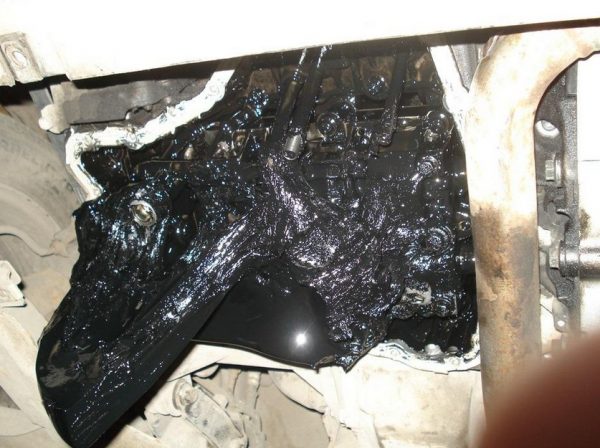
Especially strongly the viscosity of the oil increases in the bridges of the car. The gearbox is better protected in this sense, since it is located closer to the engine and receives some of the heat from it. If the oil in the transmission has thickened, the engine will have to transmit torque to it, the amount of which will be almost twice the standard. To do this, the engine will have to burn more fuel until the engine oil warms up (warming up can take from 20 minutes to 1 hour, depending on the air temperature). In the meantime, the transmission has not warmed up, fuel consumption will be 7-10% more.
Increase in aerodynamic drag
The increase in aerodynamic drag is another reason why fuel consumption increases. And this reason is inextricably linked with air temperature. As mentioned above, as the temperature decreases, the density of air increases. As a result, the scheme of air flow around the car body also changes. Aerodynamic resistance can increase by 5, and in some cases by 8%, which inevitably leads to an increase in fuel consumption. For example, at a temperature of -38 ° C, the fuel consumption of a VAZ 2106 increases by 10% when driving in the city, and by 22% when driving on country roads.

In addition, the driver himself can worsen the aerodynamics of the car by installing various decorative spoilers and similar tuning elements on it. Even an ordinary roof rack on the roof of the "seven" is able to increase winter fuel consumption by 3%. For this reason, experienced drivers try not to abuse the decorative "body kit" of their cars, especially in winter.
Tightened bearings
There are bearings on the wheel hubs of the VAZ 2107 that must not be overtightened. If the wheel bearings are overtightened, they interfere with the movement of the machine and fuel consumption increases by 4-5%. Therefore, you should especially carefully monitor the tightening torque of the hub nuts..

On the front wheels it should not exceed 24 kgf/m, and on the rear wheels it should not exceed 21 kgf/m. Compliance with this simple rule will help not only save a significant amount of gasoline, but also extend the life of the “seven” wheel bearings.
Defective carburetor
Problems with the carburetor can also cause increased fuel consumption on early VAZ 2106 models. Here are the two most common malfunctions:
- loosening the holder on the idle jet. If the holder on the fuel jet has weakened over time, then the mixture begins to leak around the jet, as it begins to hang out strongly in its nest. Thus, an excess amount of the fuel mixture appears in the combustion chambers, and this mixture gets there not only during driving, but also during idling. And the more the driver presses on the gas, the stronger the vacuum in the combustion chambers and the more excess mixture gets into them. As a result, the overall fuel consumption can increase by 25% (it all depends on how much the jet holder is loosened).
 The idle jet screw in this diagram is indicated by the number 2
The idle jet screw in this diagram is indicated by the number 2 - the needle valve in the float chamber has lost its tightness. If the tightness of this valve is lost, then the fuel gradually begins to overflow the float chamber in the carburetor. And then it reaches the combustion chambers. As a result, the driver cannot start his "seven" for a very long time. And when he finally succeeds, starting the engine is accompanied by loud pops, and fuel consumption can increase by a third.
Faulty injector
Fuel consumption on the latest models of "sevens" may increase due to problems with the injector. Most often, the injector is simply clogged.
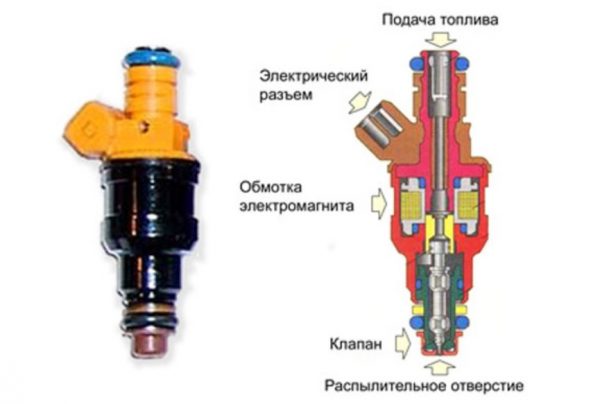
The injectors on the "seven" have a very small nozzle diameter. Therefore, even a tiny mote can seriously affect the process of creating a fuel mixture, significantly reducing the efficiency of the engine and increasing fuel consumption by 10-15%. Since the injector is clogged, it cannot create a normal fuel cloud. Gasoline that has not entered the combustion chambers begins to burn directly in the exhaust manifold. As a result, the efficiency of the motor is reduced by about 20%. All this is accompanied by an increase in the load on the electronic equipment of the machine. The ignition coil wears out faster, as do the spark plugs. And in especially severe cases, wiring can also melt.
Problems with the piston group
Problems with pistons in the VAZ 2107 engine can be identified far from immediately. But it is precisely because of them that fuel consumption can increase by 15–20%. The driver usually begins to suspect the piston group after the valves in the engine begin to ring distinctly, and the engine itself begins to growl like a tractor, and all this is accompanied by clouds of gray smoke from the exhaust pipe. All these signs indicate a sharp decrease in compression in the engine cylinders due to wear of the piston group.
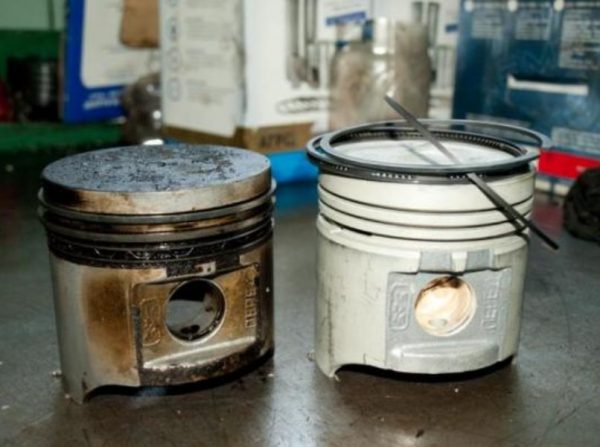
Piston rings are the most worn. They are the weakest element in this system. Sometimes valves wear out along with the rings. Then the driver begins to hear the characteristic tinkling coming from under the hood. The solution is obvious: first, the compression is measured, and if it turns out to be low, the piston rings change. If the valves are damaged along with the rings, they will also have to be changed. It should also be said here that the replacement of valves is accompanied by a very painstaking procedure for grinding them in. A novice driver is unlikely to be able to carry out this procedure on his own, so you can’t do without the help of a qualified mechanic.
Changing wheel angles
If the wheel alignment angles set during the alignment adjustment process change for some reason, this leads not only to premature tire wear, but also to an increase in fuel consumption by 2-3%. Wheels turned at unnatural angles resist the rolling of the car more, which ultimately leads to increased fuel consumption. Identifying this problem is quite simple: tires worn on one side will eloquently speak about it. At the same time, the car may begin to pull to the side while driving, and it will become more difficult to turn the steering wheel.
Measures to reduce fuel consumption
As mentioned above, the driver himself can eliminate some of the factors that cause increased fuel consumption.
Filling with gasoline with the desired octane rating
The octane number indicates how well a gasoline resists knocking. The higher the octane number, the more gasoline can be compressed in the cylinder, and the later it will explode. Therefore, if the driver wants to get as much power from the engine as possible, the engine must compress the gasoline as hard as possible.
When choosing gasoline, the owner of the VAZ 2107 must remember the general rule: if you fill the car with gasoline with an octane rating lower than the calculated one, then fuel consumption will increase. And if you fill in gasoline with a number higher than the calculated one, then the consumption will not decrease (and in some cases it will also increase). That is, if the instructions for the "seven" say that its engine is designed for AI93 gasoline, then when AI92 is filled, fuel consumption will increase. And if the engine is designed for AI92, and the driver fills in AI93 or AI95, then there will be no tangible advantages from this. Moreover, consumption may increase if the gasoline being poured turns out to be of poor quality, which is observed all the time today.
About engine overhaul
Engine overhaul is a radical and very expensive procedure. In the case of the VAZ 2107, such a procedure is far from always justified, since for the money spent on the overhaul of the motor, it is quite possible to buy another “seven” in good condition (perhaps with a small surcharge). If the driver nevertheless decided to carry out a major overhaul due to the increased appetites of the engine, then such repairs usually come down to replacing the piston rings and lapping the valves, as mentioned above.
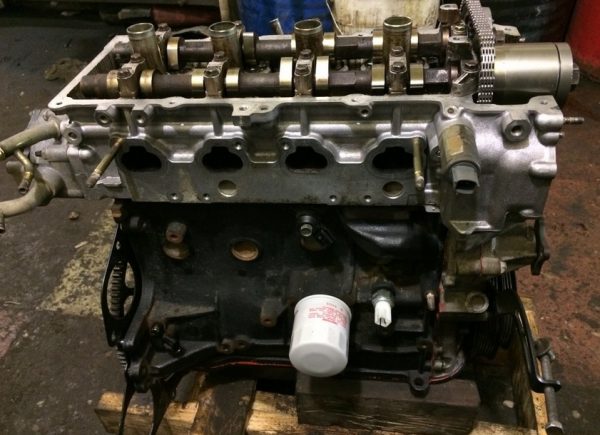
Not everyone will be able to make such repairs in a garage, since this requires a lot of special equipment and instruments (to accurately measure and adjust the compression in the cylinders, for example). Therefore, there is only one solution: drive the car to a service center and negotiate a price with qualified auto mechanics.
About warming up the engine
Warming up the engine is another simple measure a driver can take to reduce fuel consumption. This is especially true in the cold season. When starting to warm up the engine, the driver must remember: the carburetor “seven” will have to warm up longer than the injection one. The fact is that the carburetor engine cannot be operated normally until the idle speed is stabilized.
Warming up the carburetor "seven"
Here is the warm-up sequence for early VAZ 2107 models.
- The motor starts, and the air damper must be completely closed.
- After that, the damper opens a little, while making sure that the stability of the speed does not decrease.
- The driver now has two options. Option one: move off and do not wait until the engine temperature exceeds 50 ° C.
- Option two. Gradually reduce the suction until the engine runs stably without suction, and only then start moving. The warm-up time in this case will increase, but only by two to three minutes.
Video: warming up the "classics" in the cold
Warming up the injector "seven"
Warming up the injection engine has its own characteristics. In particular, summer heating is somewhat different from winter heating. The injection engine has a control unit that is able to determine the time required for complete warm-up. After that, the driver will see a signal on the dashboard indicating that the engine is ready for operation. And the engine speed will be automatically reduced. So, in the summer, the driver can drive immediately after the automatic speed reduction. And in winter it is recommended to wait 2-3 minutes, and only after that start moving.
How to adjust the carburetor
With increased fuel consumption on carburetor "sevens", the first thing to do is adjust the float. This is usually more than enough to eliminate high fuel consumption.
- The float in the VAZ 2107 carburetor has a free play: 6.4 mm in one direction, and 14 mm in the other. You can check these numbers with a special dipstick, which can be purchased at any auto parts store.

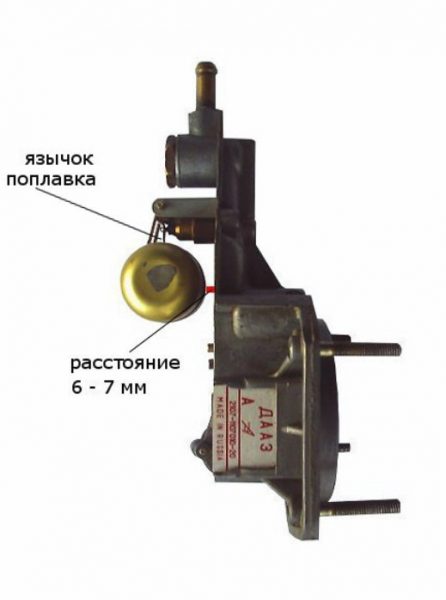 The free play of the float should not be more than 6-7 mm
The free play of the float should not be more than 6-7 mm - If the internal free play turned out to be less than 6.4 mm, then the needle valve should be slightly opened. This valve has a small tab that can be easily bent with a flathead screwdriver. As a result, the valve begins to pass more gasoline, and the free play of the float increases.
- The outer free play of the float (14 mm) is adjusted in the same way. Only in this case, the needle valve should not be slightly opened, but closed more strongly.
How to adjust the injector
If the injector “seven” consumes a lot of fuel, and the driver is firmly convinced that the reason is in the injector, then the idling of this device is usually regulated.
- The engine of the car is turned off. The battery is removed from the car.
- The idle speed controller is removed.
- The socket in which it is installed is blown with compressed air.
- The regulator is disassembled, the landing sleeve is removed from it. It is checked for wear and mechanical damage. If any are found, the sleeve is replaced with a new one.

 First, contacts are removed from the injector nozzles, then the nozzles themselves are removed from the holder
First, contacts are removed from the injector nozzles, then the nozzles themselves are removed from the holder - The injector needle is examined in the same way. At the slightest sign of damage, the needle is replaced.
- Using a multimeter, the integrity of the windings on the regulator is checked. Sandpaper thoroughly cleans all contacts of the regulator.
- After that, the regulator is installed in place, and the engine idle test begins. The engine must run for at least 15 minutes. If no problems arise, the adjustment can be considered complete.
So, increased fuel consumption is a phenomenon that depends on a huge number of factors, and not all of them can be corrected. Nevertheless, the driver may well eliminate the harmful effects of some things on his own. This will save a significant amount, because money, as you know, does not happen much.


